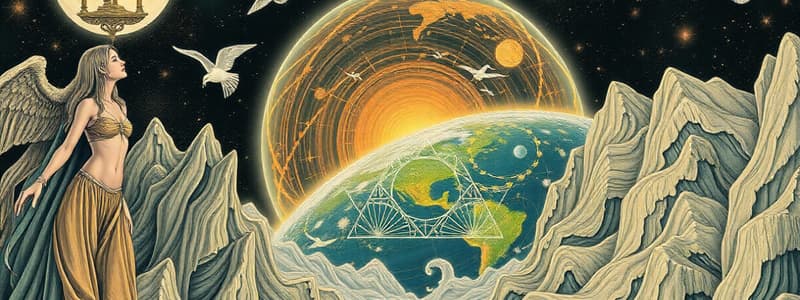Podcast
Questions and Answers
Which group of theories explains the origin of the Earth through external forces?
Which group of theories explains the origin of the Earth through external forces?
- Catastrophic theories (correct)
- Dynamic theories
- Gravitational theories
- Natural or evolutionary theories
What is the primary concept of the Nebular Hypothesis regarding the formation of the solar system?
What is the primary concept of the Nebular Hypothesis regarding the formation of the solar system?
- The solar system evolved from a single, large, rotating nebula. (correct)
- The solar system is a result of a collision between two planets.
- The solar system originated from dense clusters of matter without rotation.
- The solar system formed from multiple independent stars.
What aspect of angular momentum in the solar system contradicted the Nebular Hypothesis?
What aspect of angular momentum in the solar system contradicted the Nebular Hypothesis?
- It is spread evenly across all celestial bodies.
- It is concentrated in the sun rather than the planets.
- It increases as planets move farther from the sun.
- It is concentrated in the planets and not in the sun. (correct)
According to the Nebular Hypothesis, what happens as the nebula contracts?
According to the Nebular Hypothesis, what happens as the nebula contracts?
How did the material within the rings formed during the nebula's contraction contribute to planet formation?
How did the material within the rings formed during the nebula's contraction contribute to planet formation?
Flashcards are hidden until you start studying
Study Notes
Theories of Earth's Origin
- Earth's origin theories are classified into two main categories: External force theories and Natural or evolutionary theories.
- External force theories suggest Earth's material was pulled from the sun due to gravitational forces from a dynamic encounter with another star, often referred to as catastrophic theories.
- Natural or evolutionary theories propose that planets formed as isolated masses from the material that condensed around the sun.
Nebular Hypothesis
- Proposed by Kant and Laplace in 1796, serving as one of the earliest theories explaining solar system formation.
- This hypothesis posits that the solar system originated from a large, flat, rotating nebula that extended beyond the farthest planet.
- As the nebula contracted, material concentrated towards the center, leading to an increase in rotational speed due to the conservation of angular momentum.
- During this contraction, the outer rim of the nebula achieved a velocity where centrifugal force equaled gravitational pull; this scenario left behind rings of matter.
- Successive contraction resulted in the formation of these rings, which eventually coalesced into planets and satellites.
- The Nebular Hypothesis faced rejection due to findings indicating that angular momentum is primarily contained in the planets rather than the sun, conflicting with the theory.
- The idea of mass rotating more rapidly as it condensed was also found to be incompatible with this hypothesis.
Studying That Suits You
Use AI to generate personalized quizzes and flashcards to suit your learning preferences.



